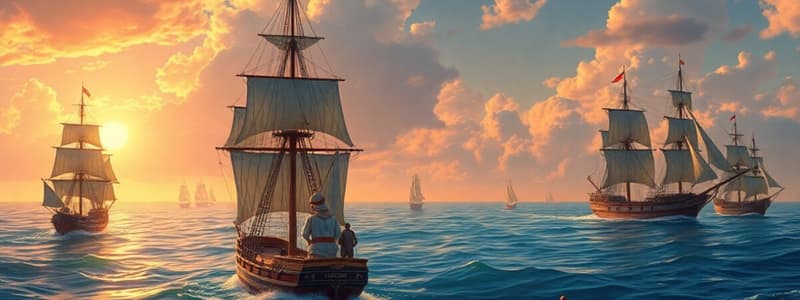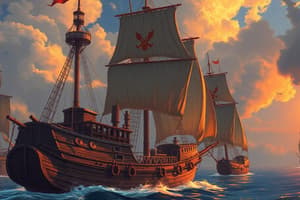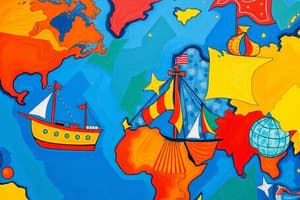Podcast
Questions and Answers
Which of the following best describes the primary contrast between Unit 3 and Unit 4 in a typical world history curriculum?
Which of the following best describes the primary contrast between Unit 3 and Unit 4 in a typical world history curriculum?
- Unit 3 explores political revolutions, while Unit 4 explores industrial revolutions.
- Unit 3 focuses on the Americas, while Unit 4 focuses on Europe.
- Unit 3 examines land-based empires, while Unit 4 examines maritime empires. (correct)
- Unit 3 covers the period after 1750, while Unit 4 covers the period before 1450.
What historical thinking skill involves understanding the time period before a topic to understand its origins?
What historical thinking skill involves understanding the time period before a topic to understand its origins?
- Comparison
- Change and Continuity
- Contextualization (correct)
- Causation
Which technological advancement, originating in China, played a crucial role in enabling European exploration by providing a military advantage?
Which technological advancement, originating in China, played a crucial role in enabling European exploration by providing a military advantage?
- The compass
- The astrolabe
- The printing press
- Gunpowder (correct)
Which of the following statements accurately reflects the relationship between the Renaissance/Scientific Revolution and cross-cultural interactions?
Which of the following statements accurately reflects the relationship between the Renaissance/Scientific Revolution and cross-cultural interactions?
How did the understanding of wind currents, particularly the volta do mar, contribute to maritime exploration?
How did the understanding of wind currents, particularly the volta do mar, contribute to maritime exploration?
Which explorer's voyage in 1492 is a key example of exploration during the 'Maritime Empires' period?
Which explorer's voyage in 1492 is a key example of exploration during the 'Maritime Empires' period?
What was the primary initial motivation for Portuguese exploration in the 15th century?
What was the primary initial motivation for Portuguese exploration in the 15th century?
What was the significance of the astrolabe in the context of maritime exploration?
What was the significance of the astrolabe in the context of maritime exploration?
Which of the following best describes the primary goal of mercantilism during the Commercial Revolution?
Which of the following best describes the primary goal of mercantilism during the Commercial Revolution?
How did the establishment of colonies contribute to the economic goals of mercantilist nations?
How did the establishment of colonies contribute to the economic goals of mercantilist nations?
What was the most significant change in trade patterns during the period described?
What was the most significant change in trade patterns during the period described?
Which statement accurately reflects the role of Muslim merchants in trade networks during the period?
Which statement accurately reflects the role of Muslim merchants in trade networks during the period?
How did Spain establish and maintain control over its colonies in the Americas?
How did Spain establish and maintain control over its colonies in the Americas?
Why was the caste system significant in Spanish colonies?
Why was the caste system significant in Spanish colonies?
What role did religious beliefs play in establishing legitimacy of rule during this era?
What role did religious beliefs play in establishing legitimacy of rule during this era?
Which of the following best describes syncretism in the context of religious beliefs during this period?
Which of the following best describes syncretism in the context of religious beliefs during this period?
What primary motivation drove European explorers to seek a direct sea route to the Indian Ocean during the Age of Exploration?
What primary motivation drove European explorers to seek a direct sea route to the Indian Ocean during the Age of Exploration?
How did the Treaty of Tordesillas (1494) influence the colonization of South America?
How did the Treaty of Tordesillas (1494) influence the colonization of South America?
Which of the following best describes the long-term impact of diseases introduced to the New World during the Columbian Exchange?
Which of the following best describes the long-term impact of diseases introduced to the New World during the Columbian Exchange?
What role did silver play in Spain's global economic activities during the 16th and 17th centuries?
What role did silver play in Spain's global economic activities during the 16th and 17th centuries?
Which statement accurately reflects a contrast between Spanish and French colonial approaches in North America?
Which statement accurately reflects a contrast between Spanish and French colonial approaches in North America?
How did the 'repartimiento' system differ from the 'encomienda' system in Spanish colonial America?
How did the 'repartimiento' system differ from the 'encomienda' system in Spanish colonial America?
Which of the following factors contributed most significantly to the success of the Spanish conquistadors in conquering the Aztec and Inca empires?
Which of the following factors contributed most significantly to the success of the Spanish conquistadors in conquering the Aztec and Inca empires?
What was the primary goal of Henry Hudson's voyages sponsored by the Dutch?
What was the primary goal of Henry Hudson's voyages sponsored by the Dutch?
Which of the following crops, originating in the Americas, had a significant impact on European agriculture and population growth?
Which of the following crops, originating in the Americas, had a significant impact on European agriculture and population growth?
The phrase 'God, Gold, and Glory' is often to describe the motivations behind European exploration. Which of the following best explains the 'Glory' component?
The phrase 'God, Gold, and Glory' is often to describe the motivations behind European exploration. Which of the following best explains the 'Glory' component?
What role did the Audiencias play in the Spanish colonial administration?
What role did the Audiencias play in the Spanish colonial administration?
Why did the Dutch establish New Amsterdam in North America?
Why did the Dutch establish New Amsterdam in North America?
Which explorer is credited with leading the expedition that resulted in the Spanish conquest of the Aztec Empire?
Which explorer is credited with leading the expedition that resulted in the Spanish conquest of the Aztec Empire?
What was a primary difference between Portuguese and Spanish colonization strategies during the early modern period?
What was a primary difference between Portuguese and Spanish colonization strategies during the early modern period?
Which explorer, sponsored by England, is credited with exploring North America?
Which explorer, sponsored by England, is credited with exploring North America?
Flashcards
Maritime Empires
Maritime Empires
Period from 1450-1750, focuses on empires established via sea routes.
Contextualization
Contextualization
Understanding the context of an event by examining the events and trends before it.
The Crusades
The Crusades
Introduced Europe to classical knowledge and medical advancements from Islamic civilizations.
Heliocentric Theory
Heliocentric Theory
Signup and view all the flashcards
Astrolabe
Astrolabe
Signup and view all the flashcards
Lateen Sails
Lateen Sails
Signup and view all the flashcards
Volta do mar
Volta do mar
Signup and view all the flashcards
Major European States in Exploration
Major European States in Exploration
Signup and view all the flashcards
Bartholomew Diaz
Bartholomew Diaz
Signup and view all the flashcards
Vasco da Gama
Vasco da Gama
Signup and view all the flashcards
Ferdinand and Isabella
Ferdinand and Isabella
Signup and view all the flashcards
Columbian Exchange
Columbian Exchange
Signup and view all the flashcards
Foods from Americas to Europe
Foods from Americas to Europe
Signup and view all the flashcards
Foods from Europe to Americas
Foods from Europe to Americas
Signup and view all the flashcards
God, Gold, Glory
God, Gold, Glory
Signup and view all the flashcards
Old World Diseases
Old World Diseases
Signup and view all the flashcards
Conquistadors
Conquistadors
Signup and view all the flashcards
Viceroyalty System
Viceroyalty System
Signup and view all the flashcards
Encomienda System
Encomienda System
Signup and view all the flashcards
Repartimiento System
Repartimiento System
Signup and view all the flashcards
Treaty of Tordesillas
Treaty of Tordesillas
Signup and view all the flashcards
Portuguese Colonization
Portuguese Colonization
Signup and view all the flashcards
French and Native Americans
French and Native Americans
Signup and view all the flashcards
Dutch East India Company
Dutch East India Company
Signup and view all the flashcards
Mercantilism
Mercantilism
Signup and view all the flashcards
Favorable Balance of Trade
Favorable Balance of Trade
Signup and view all the flashcards
Mother Country-Colony Relationship
Mother Country-Colony Relationship
Signup and view all the flashcards
Transatlantic Trade
Transatlantic Trade
Signup and view all the flashcards
Caste System (Spanish Colonies)
Caste System (Spanish Colonies)
Signup and view all the flashcards
Peninsulares
Peninsulares
Signup and view all the flashcards
Religious Syncretism
Religious Syncretism
Signup and view all the flashcards
Study Notes
Unit 4: Maritime Empires (Transoceanic Interconnections)
- Unit 4, called "Maritime Empires" or "Transoceanic Interconnections," contrasts with the land-based empires of Unit 3.
- The unit spans 1450-1750, concurrent with land-based empires like the Ottoman, Mughal, Ming, and Songhai.
- Exploration is a major theme, exemplified by Columbus's 1492 voyage.
- It will explore causes and effects, using historical thinking skills like change and continuity.
- Contextualization involves understanding the period before the topic to grasp its origins.
- Contextualization also means zooming out to see broader historical developments.
Technological Diffusion as Context for Exploration
- Cross-cultural interactions predate Columbus due to technological developments.
- The Crusades exposed Europe to classical thinking and medical knowledge from the Islamic world.
- Gunpowder (from the Silk Road via Mongols) and Chinese inventions like paper and the compass reached Europeans.
- The Renaissance and Scientific Revolution arose from this knowledge.
- Copernicus developed the heliocentric theory, later supported by Galileo's telescope observations.
- The Catholic Church opposed these theories, trying Galileo for heresy.
- Galileo was forced to recant, and his writings were banned, highlighting technology and learning at the time.
- Technological advancements were key for exploration.
Key Technological Advancements
- The compass, from China (Han Dynasty), spread to the Arab world and then Europe.
- The Astrolabe allowed users to determine latitude by measuring the distance made to the horizon and Sun.
- Lateen sails enabled ships like the caravel and carrick to sail in any direction, regardless of wind.
- Volta do mar is the knowledge of wind currents, enabling longer voyages.
- Cartography improved mapmaking.
- Gunpowder, developed in China and used by the Ottomans, provided a military advantage to European explorers.
Major European States in Exploration
- The major European states involved in exploration were Portugal, Spain, France, Great Britain, and the Netherlands.
- Portugal initially sought a route to the Indian Ocean for spices.
- Bartholomew Diaz reached the Cape of Good Hope (tip of Africa) in 1497.
- Vasco da Gama sailed from the Cape of Good Hope to India.
- Spain unified under Ferdinand and Isabella, who backed Christopher Columbus in 1492.
- Columbus sought a westward route to the East but landed in the Americas (Cuba and the Caribbean).
- Other Spanish explorers included Vespucci, de Leon, and Vasco da Boa.
- France, England, and the Netherlands lagged initially.
- England sponsored John Cabot to explore North America.
- The Dutch sponsored Henry Hudson, who sought a Northwest Passage but explored the Hudson River in New York.
Causes of Exploration
- Explorers sought access to spices in the Indian Ocean.
- A shortcut to the Indian Ocean bypassed taxes imposed by Islamic empires (Mughals, Safavid, Ottomans).
- Ships could carry more goods than overland routes.
- Exploration motives are summarized as "God, Gold, Glory."
- God: Spreading the Christian faith (especially Catholicism).
- Gold: Seeking material wealth (spices, goods for trade).
- Glory: Supporting the home country and rivalries between monarchies.
The Columbian Exchange
- Columbus's voyages initiated the Columbian Exchange, connecting the Old World (Europe, Asia, Africa) and the New World (Americas).
- Major exchanges included food and animals:
- From the Americas to Europe: potatoes, tomatoes, peppers, avocados, corn, beans.
- From Europe to the Americas: coffee, sugar, grapes, bananas, citrus.
- Animals from Europe to the Americas: cows, pigs, horses, chickens.
- Grains from Europe to the Americas: wheat, rice, barley, oats.
- Diets changed which led to an increased global population.
Disease Exchange
- The New World lacked immunity to Old World diseases.
- Diseases transmitted to the New World included smallpox, measles, malaria, chicken pox, and yellow fever.
- Smallpox caused the largest death tolls among indigenous Americans, surpassing wars and the Black Death.
- Diseases caused massive population loss in the short term for Americans, while increasing population in the Old World.
Economic Effects of the Columbian Exchange
- New cash crop industries arose in the New World (sugar, tobacco, cotton).
- Resulting in forced labor from indigenous Americans.
- As native populations declined due to disease, the Atlantic slave trade emerged.
Empire Building and Maintenance (Spain)
- Spain led in American conquest via conquistadors exploring Central and South America.
- Hernan Cortes conquered the Aztec Empire (Mexico); Francisco Pizarro, the Incan Empire (Peru).
- Jared Diamond's "Guns, Germs, and Steel" explains this: Europeans had domesticated animals and advanced agriculture, enabling specialization, technology (metallurgy, gunpowder), and stronger weapons.
- Europe was in the bronze and iron ages while the Americas we're still primite ages.
- Spain used the Viceroyalty system, dividing colonies into viceroyalties led by viceroys reporting to the Spanish monarch.
- The most famous were the Viceroyalty of New Spain (Mexico, established in 1521) and the Viceroyalty of Peru (established in 1534).
- The Viceroyalty of New Spain also governed colonies in the Caribbean and the Philippines (established in 1565).
- Audiencias oversaw administration, with judges and lawyers, providing a means for people to voice concerns.
- Missionaries converted native populations to Roman Catholicism.
- The economy was based on mining and ranching, relying on coercion of the natives.
Forced Labor Systems (Encomienda and Repartimiento)
- The Encomienda system granted Spanish landowners native laborers who paid tribute for protection.
- Bartholomew de las Casas, a Catholic missionary, documented mistreatment in the encomienda system, leading to the repartimiento system.
- The Repartimiento system replaced the encomienda, allotting natives to work for a few weeks while retaining some freedom.
- The goal was to reduce abuses, but the native population had already declined significantly.
- The Atlantic slave trade arose from population shortages and the demand for labor.
- Enslaved Africans were captured and sold in West and Central Africa, enduring horrific treatment during the Middle Passage.
- Silver mines such as Potosi, in Mexico and Peru, drove Spanish exploration.
- Silver was used to buy Chinese goods such as porcelain and Silk.
The Treaty of Tordesillas
- Portugal and Spain signed the Treaty of Tordesillas to resolve land disputes.
- It divided the world along a north-south line, granting Spain the west and Portugal the east.
- This allowed Portugal to settle eastern South America (modern-day Brazil).
- Brazil speaks Portuguese due to this treaty.
Portuguese Colonization
- Unlike others, they prioritized trade over colonization.
- Their focus was on setting up coastal African trading posts, forming relationships with Congo, Ndongo, and Queen Nzinga.
Other European Empires
- Great Britain, France, and the Netherlands sought an alternative route to Asia, establishing colonies: exploring North America and the Spice Islands.
- The British established the 13 American colonies and the British East India Company.
- The French established forts and trading posts from New France and Canada, such as Quebec and Montreal and down the Mississippi and into Louisiana .
- The French had a better relationship with Native Americans, respecting their beliefs, not taking large parts of their land, and working alongside them in a mutually beneficial relationship.
- Netherlands, established New Amsterdam in North America (modern-day New York.
- The Dutch established colonies in the Caribbean, near the Cape Colony in South Africa, and in the Indian Ocean.
- The Dutch East India Company was a joint-stock company where merchants pooled resources and shared risks and rewards controlling routes through the Spice Islands
- Major competitor was the Portuguese.
Mercantilism
- The big five countries aimed to accumulate capital under mercantilism.
- Resulted in Commercial Revolution, with the idea that there was a set amount of wealth that had to be obtained as much as possible.
- Mother country would want a favorable balance of trade with more exports than imports
- Colonization was the best way to gain gold or silver
- Colonies would give mother countries raw resource and they would turn these into goods and sell as product back to the colonies.
Continuities in Trade
- The biggest change was the rise of transatlantic trade routes.
- Overland routes declined in merchant activity.
- There was a persistent desire for Indian Ocean trade goods.
- Muslim Merchants traveled these trade routes and were present in North Africa and the Indian Ocean.
Social Structures and Religious Beliefs
- Spain established viceroyalties, leading more Spaniards to move to the colonies.
- Resulting in a very distinct social hierarchy
- Peninsulares: People that come from Spain.
- Creoles: People of Spanish descent born is America.
- Mestizos: People with Spanish and Indigenous descent.
- Mulattos: People of Spanish and African descent.
- Ranked Indigenous and Enslaved people with less rights.
Caste System
- Social classes were divided based on the race of the person.
- System determined access to taxation and legal rights.
- Helped the Spanish maintain their power in the Empire.
Religions
- Legitimacy of rule was often established through use of religious beliefs.
- Roman Catholicism expanded in the regions.
- Syncretic beliefs emerged, blending Old and New World traditions, such as Santeria and Vodun.
Studying That Suits You
Use AI to generate personalized quizzes and flashcards to suit your learning preferences.




